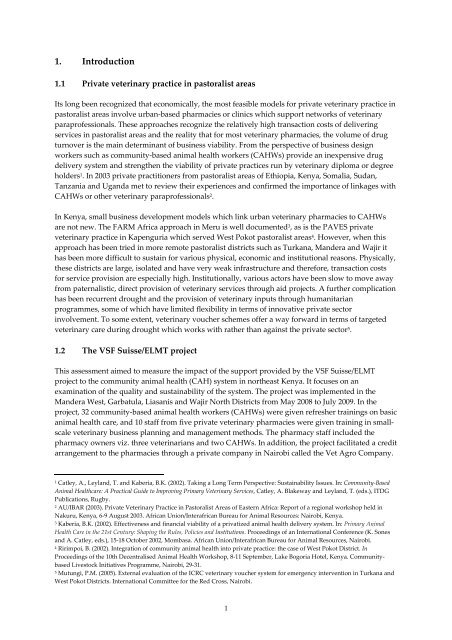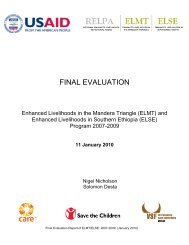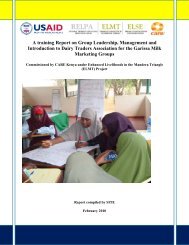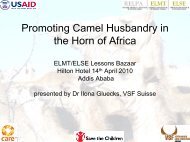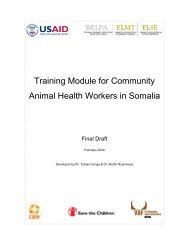Impact Assessment of the Community Animal Health System in ...
Impact Assessment of the Community Animal Health System in ...
Impact Assessment of the Community Animal Health System in ...
Create successful ePaper yourself
Turn your PDF publications into a flip-book with our unique Google optimized e-Paper software.
1. Introduction<br />
1.1 Private veter<strong>in</strong>ary practice <strong>in</strong> pastoralist areas<br />
Its long been recognized that economically, <strong>the</strong> most feasible models for private veter<strong>in</strong>ary practice <strong>in</strong><br />
pastoralist areas <strong>in</strong>volve urban‐based pharmacies or cl<strong>in</strong>ics which support networks <strong>of</strong> veter<strong>in</strong>ary<br />
parapr<strong>of</strong>essionals. These approaches recognize <strong>the</strong> relatively high transaction costs <strong>of</strong> deliver<strong>in</strong>g<br />
services <strong>in</strong> pastoralist areas and <strong>the</strong> reality that for most veter<strong>in</strong>ary pharmacies, <strong>the</strong> volume <strong>of</strong> drug<br />
turnover is <strong>the</strong> ma<strong>in</strong> determ<strong>in</strong>ant <strong>of</strong> bus<strong>in</strong>ess viability. From <strong>the</strong> perspective <strong>of</strong> bus<strong>in</strong>ess design<br />
workers such as community‐based animal health workers (CAHWs) provide an <strong>in</strong>expensive drug<br />
delivery system and streng<strong>the</strong>n <strong>the</strong> viability <strong>of</strong> private practices run by veter<strong>in</strong>ary diploma or degree<br />
holders 1 . In 2003 private practitioners from pastoralist areas <strong>of</strong> Ethiopia, Kenya, Somalia, Sudan,<br />
Tanzania and Uganda met to review <strong>the</strong>ir experiences and confirmed <strong>the</strong> importance <strong>of</strong> l<strong>in</strong>kages with<br />
CAHWs or o<strong>the</strong>r veter<strong>in</strong>ary parapr<strong>of</strong>essionals 2 .<br />
In Kenya, small bus<strong>in</strong>ess development models which l<strong>in</strong>k urban veter<strong>in</strong>ary pharmacies to CAHWs<br />
are not new. The FARM Africa approach <strong>in</strong> Meru is well documented 3 , as is <strong>the</strong> PAVES private<br />
veter<strong>in</strong>ary practice <strong>in</strong> Kapenguria which served West Pokot pastoralist areas 4 . However, when this<br />
approach has been tried <strong>in</strong> more remote pastoralist districts such as Turkana, Mandera and Wajir it<br />
has been more difficult to susta<strong>in</strong> for various physical, economic and <strong>in</strong>stitutional reasons. Physically,<br />
<strong>the</strong>se districts are large, isolated and have very weak <strong>in</strong>frastructure and <strong>the</strong>refore, transaction costs<br />
for service provision are especially high. Institutionally, various actors have been slow to move away<br />
from paternalistic, direct provision <strong>of</strong> veter<strong>in</strong>ary services through aid projects. A fur<strong>the</strong>r complication<br />
has been recurrent drought and <strong>the</strong> provision <strong>of</strong> veter<strong>in</strong>ary <strong>in</strong>puts through humanitarian<br />
programmes, some <strong>of</strong> which have limited flexibility <strong>in</strong> terms <strong>of</strong> <strong>in</strong>novative private sector<br />
<strong>in</strong>volvement. To some extent, veter<strong>in</strong>ary voucher schemes <strong>of</strong>fer a way forward <strong>in</strong> terms <strong>of</strong> targeted<br />
veter<strong>in</strong>ary care dur<strong>in</strong>g drought which works with ra<strong>the</strong>r than aga<strong>in</strong>st <strong>the</strong> private sector 5 .<br />
1.2 The VSF Suisse/ELMT project<br />
This assessment aimed to measure <strong>the</strong> impact <strong>of</strong> <strong>the</strong> support provided by <strong>the</strong> VSF Suisse/ELMT<br />
project to <strong>the</strong> community animal health (CAH) system <strong>in</strong> nor<strong>the</strong>ast Kenya. It focuses on an<br />
exam<strong>in</strong>ation <strong>of</strong> <strong>the</strong> quality and susta<strong>in</strong>ability <strong>of</strong> <strong>the</strong> system. The project was implemented <strong>in</strong> <strong>the</strong><br />
Mandera West, Garbatula, Liasanis and Wajir North Districts from May 2008 to July 2009. In <strong>the</strong><br />
project, 32 community‐based animal health workers (CAHWs) were given refresher tra<strong>in</strong><strong>in</strong>gs on basic<br />
animal health care, and 10 staff from five private veter<strong>in</strong>ary pharmacies were given tra<strong>in</strong><strong>in</strong>g <strong>in</strong> smallscale<br />
veter<strong>in</strong>ary bus<strong>in</strong>ess plann<strong>in</strong>g and management methods. The pharmacy staff <strong>in</strong>cluded <strong>the</strong><br />
pharmacy owners viz. three veter<strong>in</strong>arians and two CAHWs. In addition, <strong>the</strong> project facilitated a credit<br />
arrangement to <strong>the</strong> pharmacies through a private company <strong>in</strong> Nairobi called <strong>the</strong> Vet Agro Company.<br />
1 Catley, A., Leyland, T. and Kaberia, B.K. (2002). Tak<strong>in</strong>g a Long Term Perspective: Susta<strong>in</strong>ability Issues. In: <strong>Community</strong>‐Based<br />
<strong>Animal</strong> <strong>Health</strong>care: A Practical Guide to Improv<strong>in</strong>g Primary Veter<strong>in</strong>ary Services, Catley, A. Blakeway and Leyland, T. (eds.), ITDG<br />
Publications, Rugby.<br />
2 AU/IBAR (2003). Private Veter<strong>in</strong>ary Practice <strong>in</strong> Pastoralist Areas <strong>of</strong> Eastern Africa: Report <strong>of</strong> a regional workshop held <strong>in</strong><br />
Nakuru, Kenya, 6‐9 August 2003. African Union/Interafrican Bureau for <strong>Animal</strong> Resources: Nairobi, Kenya.<br />
3 Kaberia, B.K. (2002). Effectiveness and f<strong>in</strong>ancial viability <strong>of</strong> a privatized animal health delivery system. In: Primary <strong>Animal</strong><br />
<strong>Health</strong> Care <strong>in</strong> <strong>the</strong> 21st Century: Shap<strong>in</strong>g <strong>the</strong> Rules, Policies and Institutions. Proceed<strong>in</strong>gs <strong>of</strong> an International Conference (K. Sones<br />
and A. Catley, eds.), 15‐18 October 2002, Mombasa. African Union/Interafrican Bureau for <strong>Animal</strong> Resources, Nairobi.<br />
4 Ririmpoi, B. (2002). Integration <strong>of</strong> community animal health <strong>in</strong>to private practice: <strong>the</strong> case <strong>of</strong> West Pokot District. In<br />
Proceed<strong>in</strong>gs <strong>of</strong> <strong>the</strong> 10th Decentralised <strong>Animal</strong> <strong>Health</strong> Workshop, 8‐11 September, Lake Bogoria Hotel, Kenya. <strong>Community</strong>based<br />
Livestock Initiatives Programme, Nairobi, 29‐31.<br />
5 Mutungi, P.M. (2005). External evaluation <strong>of</strong> <strong>the</strong> ICRC veter<strong>in</strong>ary voucher system for emergency <strong>in</strong>tervention <strong>in</strong> Turkana and<br />
West Pokot Districts. International Committee for <strong>the</strong> Red Cross, Nairobi.<br />
1


